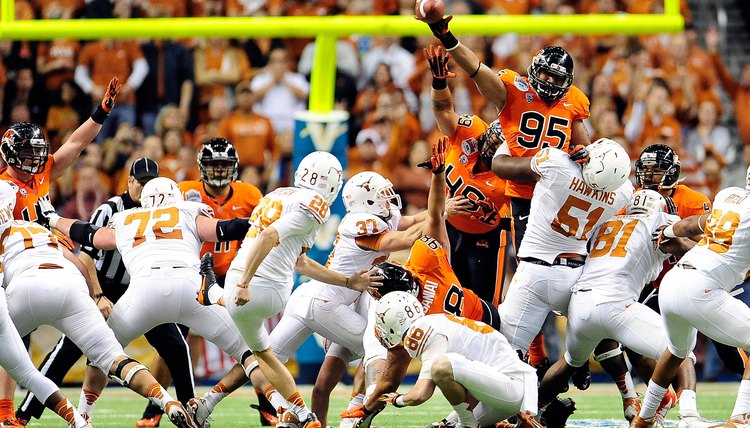What Is the Leaping Penalty in Football?

Jumping is a normal part of a football game. Receivers and defensive backs must leap to try to catch, or intercept, high passes. Defensive linemen jump to try to block passes. Ball carriers leap horizontally over potential tacklers diving at their legs. These are all legal plays. Additionally, defensive players often jump into the air to try to block field-goal or extra-point attempts. Those leaps are also typically legal, but can become illegal if a leaper lands on another player.
Leaping Penalty
Leaping to block a kick may be illegal under Rule 12, Section 3, Article 1(q) of the NFL rules. Article 1 of Section 3 lists all acts that the NFL considers to be unsportsmanlike conduct, which includes, “Running forward and leaping in an obvious attempt to block a field goal or (extra point) …” Players lined up within 1 yard of the line of scrimmage when the ball is snapped are exempt from the leaping penalty. The NCAA has a similarly worded rule that applies to college football, although the college penalty is considered a personal foul.
Consequences
A team called for leaping is assessed a 15-yard penalty from the previous line of scrimmage, or half the distance to the goal line if the line of scrimmage was inside the 30-yard line. Additionally, the player may be ejected from the game. If the penalty occurs during a field-goal attempt, the offensive team also receives an automatic first down, even if it previously needed more than 15 yards to gain a first down. If the penalty occurs during an extra-point try, the team can repeat the kick if it is blocked. The penalty is assessed on the ensuing kickoff if the extra point kick is good.
Purpose of the Leaping Rule
The leaping rule is designed to prevent players from lining up well past the line of scrimmage, getting a running start, then using their momentum to leap into the air and block a kick. The main focus of the rule, however, is player safety, because of the potential for injury if the leaper lands on another player. Significantly, the penalty is assessed even if the leaper lands on a teammate.
Rarely Called Rule
Leaping penalties are rarely called because leaping from beyond the line of scrimmage is rarely attempted. Running up to the line and jumping to block a kick successfully is difficult enough; doing so without landing on one of the players congregated at the scrimmage line is almost impossible. In 2003 in a game against the Indianapolis Colts, a leaping attempt backfired when Tampa Bay Buccaneers lineman Simeon Rice ran forward from 4 yards behind the line of scrimmage to try to block Mike Vanderjagt’s 40-yard field goal try in overtime. Rice didn’t block the kick, which missed. Tampa was assessed a leaping penalty, which moved the ball half the distance to goal line, after which Vanderjagt booted a game-winning, 29-yard field goalm for the Colts.
References
Writer Bio
M.L. Rose has worked as a print and online journalist for more than 20 years. He has contributed to a variety of national and local publications, specializing in sports writing. Rose holds a B.A. in communications.
